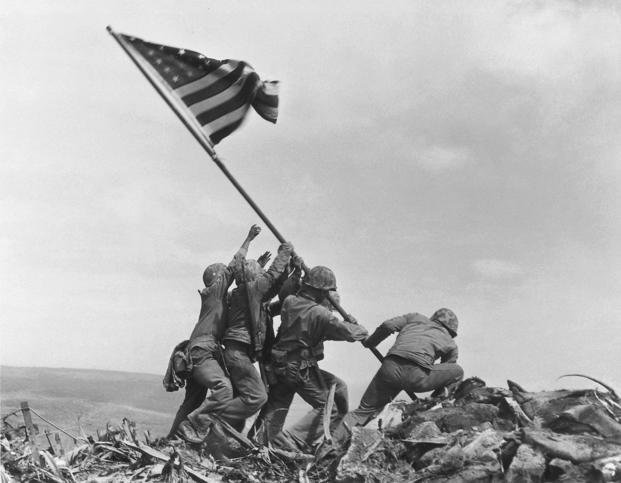Joe Rosenthal missed the moment when United States Marines first raised the American flag over Mount Suribachi during the Battle of Iwo Jima. The Associated Press photographer was still climbing up the mountain at the time.
But when Marines raised another flag, he was there to capture the image for the ages. And he would spend the rest of the war arguing over whether he'd staged the second raising.
Fighting on Iwo Jima lasted 36 days, but it took the Marines only five days to reach the top of the eight-square-mile island's highest point, Mount Suribachi. Almost from the get-go, the fighting was brutal. Japan had a year to reinforce the island with tunnels carved into the mountainside, hidden artillery positions and a network of reinforced bunkers.
Read: 6 Reasons Why the Battle of Iwo Jima Is So Important to Marines
Allied bombing and naval barrages could do nothing to soften the island's defenses for the attacking Marines. When they landed, they were facing the full force of its Japanese defenders, who were willing to fight to the death for every inch of volcanic rock.
So when the Marines topped Suribachi and planted the first flag on Feb. 23, 1945, it was a huge boon to the Marines fighting below and the sailors offshore. The ships blew their horns when they saw the flag. Gunfire and cheers erupted from the sailors, Marines and Coast Guardsmen fighting below.
Gunfire also erupted from the Japanese soldiers, who saw the flag as just a new target atop the island's highest peak. After the flag was raised, a hail of bullets came in around the Marines on Mount Suribachi.
Marine Staff Sgt. Louis Lowery of Leatherneck Magazine was there to capture the first raising, but had to dive for cover when the enemy started shooting. His camera was broken in the fall, and he had to go back down the mountain to get new gear. On his way to the rear, he passed Rosenthal and his Graflex 4x5 camera. The AP representative was about to get something few war photographers ever did: a second chance at capturing the moment.

By the time Rosenthal reached the top, the first flag was still there. Like any good photographer, he waited around to see what came next. He didn't have to wait long.
After seeing how the American troops responded to the first flag being raised, Marine Corps Lt. Col. Chandler Johnson ordered a new, larger flag to be raised over the battlefield. This 96 x 56-inch flag would be one that could be seen across the island.
Rosenthal was present for this flag raising, but he almost missed the second moment, too.
Marine Sgt. William Genaust was filming the moment and asked Rosenthal whether he was in his way. The AP photographer turned to look at Genaust and realized the Marines were raising the flag.
He had to snap the now-iconic photo without looking into the viewfinder. His next shot was a group photo of 16 Marines and two Navy corpsmen around the raised flag.
"Out of the corner of my eye, I had seen the men start the flag up," he later told Colliers Magazine. "I swung my camera and shot the scene. That is how the picture was taken, and when you take a picture like that, you don't come away saying you got a great shot. You don't know."
Rosenthal sent the photo to be processed on Guam, where it was quickly sent out to The Associated Press in New York. Within 17 hours of the flag raising, the photo was on the newswires -- and on the desk of President Franklin D. Roosevelt.

It won a Pulitzer Prize for photography in 1945 and became a symbol of the enduring spirit of United States Marines.
In 1951, a former petty officer and sculptor named Felix de Weldon was commissioned to design a national memorial for the Marine Corps to be built in the Washington, D.C., area. He chose a sculpture of the image of the Marines on Mount Suribachi. It took three years to build the 78-foot-tall United States Marine Corps War Memorial, which was dedicated in 1954.
-- Blake Stilwell can be reached at blake.stilwell@military.com. He can also be found on Twitter @blakestilwell or on Facebook.
Want to Learn More About Military Life?
Whether you're thinking of joining the military, looking for post-military careers or keeping up with military life and benefits, Military.com has you covered. Subscribe to Military.com to have military news, updates and resources delivered directly to your inbox.















